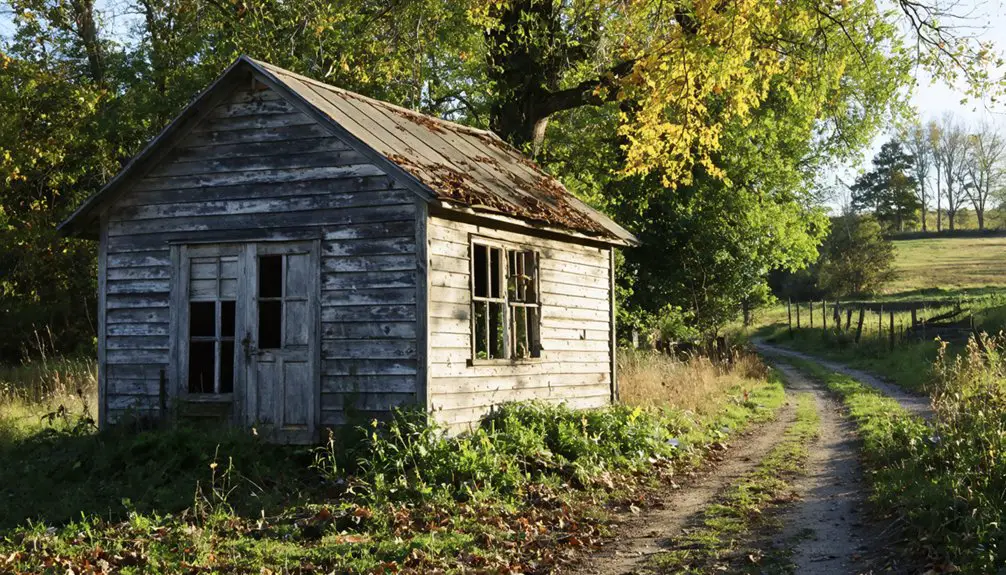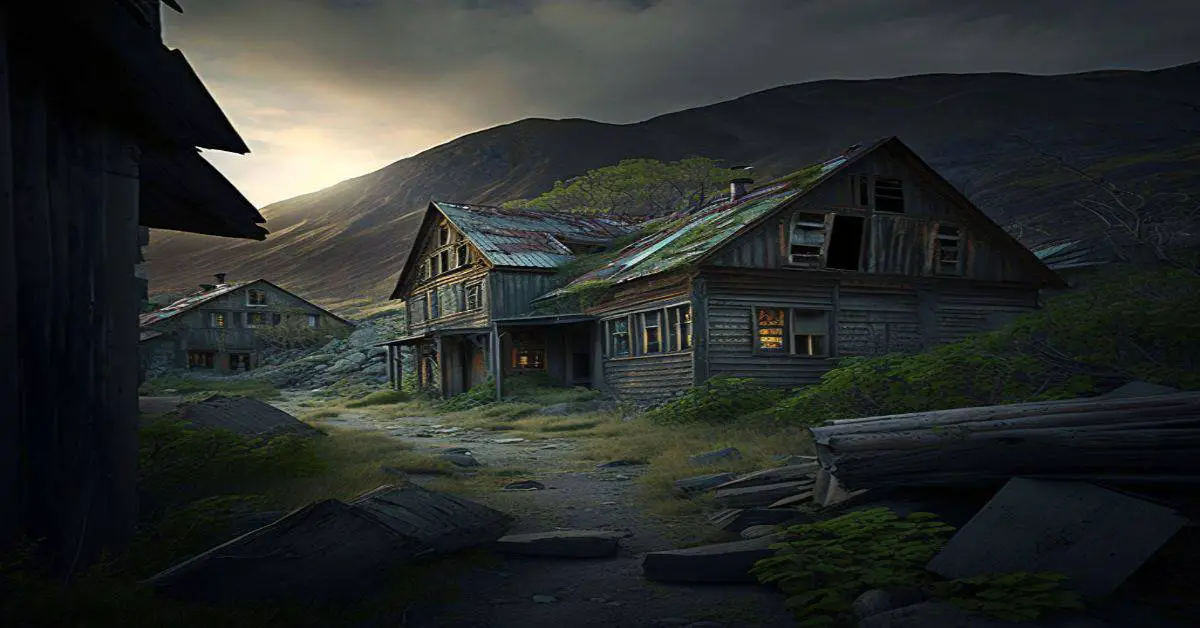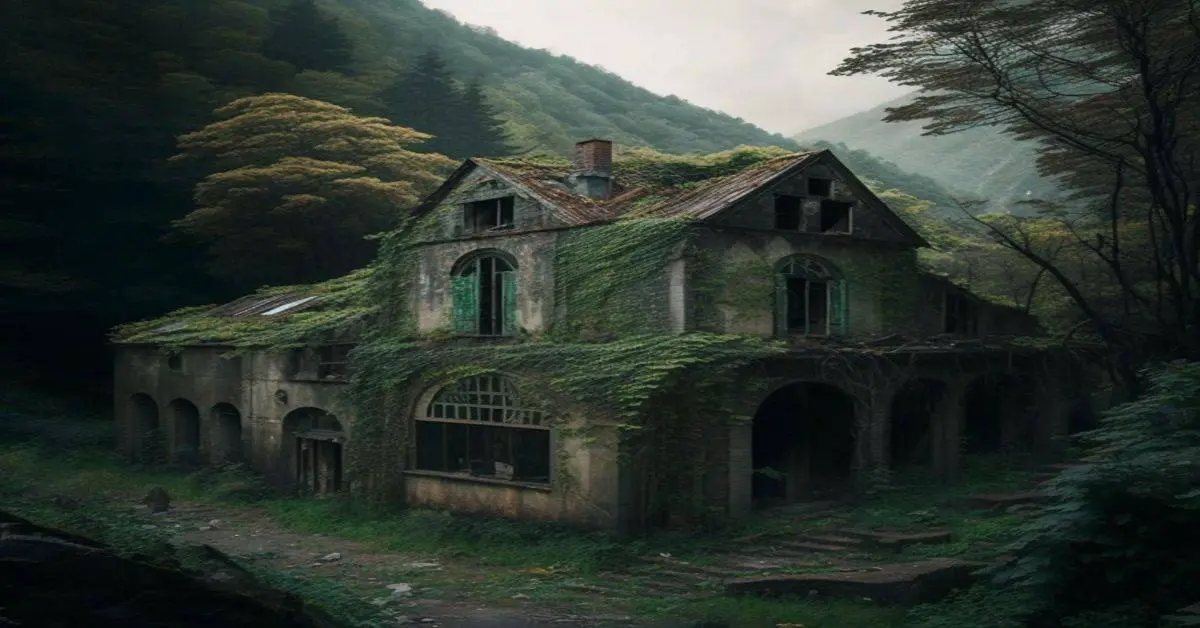You’ll discover Havre as one of Michigan’s most intriguing ghost towns, established in the 1830s through Alex Joudon’s 600-acre land acquisition. The town flourished as a lumber hub, with the Schomberg Hardwood Lumber Company producing 8 million board feet annually. Daily life centered around the church and one-room schoolhouse until economic changes, dwindling resources, and the Great Depression led to its abandonment. Sand dunes now cover the original town site, though scattered artifacts tell a deeper story.
Key Takeaways
- Havre was established in 1835 as a promising settlement near the Great Lakes, founded by Alex Joudon who secured 600 acres.
- The town’s economy relied heavily on the Schomberg Hardwood Lumber Company, producing 8 million board feet of lumber annually.
- Daily life revolved around a one-room schoolhouse and church, with strong community bonds through social gatherings and events.
- Economic decline began when timber resources were depleted, leading to business closures and population exodus during the Great Depression.
- Sand dunes now cover most of Havre’s original location, with only scattered artifacts and remnants revealing its past existence.
Origins and Early Settlement
During the early nineteenth century, the northern Michigan settlement of Havre emerged as a strategic location near the Great Lakes, on land previously inhabited by Native American tribes. The region’s fertile soil and access to waterways made it attractive to ambitious settlers from eastern states like Pennsylvania and New York.
In 1835, Alex Joudon spearheaded land acquisition efforts, gathering a group of affluent investors who shared his vision for development. Through his company, he secured 600 acres of land for the ambitious project. The investment group established The Port Sheldon Land Company to oversee the development. Settler motivations centered on establishing a thriving commercial hub, with many bringing expertise in agriculture, trade, and industry.
These pioneers formed land companies to manage property and orchestrate town planning, recognizing the area’s potential for growth. The ecosystem’s abundance of timber and wild berries, combined with its strategic location, promised opportunities for those seeking their fortune in Michigan’s frontier.
Economic Rise and Fall
You’ll find Havre’s economic trajectory tightly linked to the Schomberg Hardwood Lumber Company‘s expansion near Good Harbor, where their mill operated day and night to produce up to 8 million board feet of lumber annually at its peak.
Like many mining settlements that yielded over 50 million pounds of valuable resources, Havre experienced both dramatic growth and eventual decline.
The town’s growth accelerated with enlarged dock facilities that could load four schooners simultaneously, enabling robust trade in both lumber and agricultural products. Similar to the Copper Range Railroad that served Freda until 1971, Havre’s transportation infrastructure played a vital role in its commercial success.
Early Trade and Commerce
While early settlers established Havre as a promising trade center, the town’s commercial ventures began with basic necessities that supported both residents and travelers. General stores and post offices formed the backbone of early trade networks, facilitating the exchange of goods like whiskey and daily essentials. These establishments served as crucial communication hubs for business correspondence and commerce. Like many Michigan towns, having a post office established was vital to its development and survival.
The town’s economic vulnerabilities became apparent as its commercial success hinged heavily on railroad access and waterway transport. Despite investments in lodgings and warehouses to support anticipated growth, Havre’s trade potential never fully materialized. Similar to the financial crisis of 1837, the town struggled with economic instability that threatened its survival.
The town’s dependence on limited transportation routes and singular markets ultimately restricted its ability to compete with better-connected neighboring communities, setting the stage for its eventual decline.
Resource-Driven Development
Like many Michigan settlements of the 1800s, Havre’s initial prosperity stemmed from abundant natural resources, particularly timber.
You’ll find that sawmills quickly emerged as the town’s economic backbone, drawing workers and businesses while spurring rapid infrastructure development through railroads and piers.
Early settlers similarly faced transportation challenges, with farm produce wagons stretching for miles to reach markets.
Without sustainable practices or proper resource management, Havre’s boom period couldn’t last. The town faced similar challenges to Aral, where the mill burned down in 1899.
Once timber supplies dwindled, the town’s economy began to crumble. You can trace the familiar pattern: overcapitalized ventures failed, workers moved away, and businesses shut down.
While some Michigan ghost towns successfully adapted to agriculture or manufacturing, Havre struggled to diversify its economic base.
The town’s story serves as a stark reminder that long-term survival depends on more than just extracting resources – it requires planning for the future.
Industrial Decline Patterns
The industrial decline of Havre followed a pattern common to many Michigan ghost towns of the era.
You’ll recognize the familiar sequence: technological shifts made older operations obsolete, while the change from charcoal to coke fuel transformed the economics of smelting. As industrial infrastructure aged without proper upgrades, the town’s competitive position weakened against more modernized facilities.
The most devastating impact came from industrial shifts and economic volatility in the market. The town’s iron smelting operations produced over 230,000 tons of iron before succumbing to market pressures. Like many towns during Michigan’s boom-and-bust cycles, Havre’s prosperity was tied to the exploitation of natural resources.
When the primary industry faltered, you’d see the domino effect: job losses triggered population exodus, subsidiary businesses collapsed, and the tax base eroded.
Without economic diversification to cushion the blow, Havre’s fate was sealed. The town’s dependency on a single industry left it particularly vulnerable when market conditions deteriorated, ultimately leading to its abandonment.
Daily Life in Historic Havre
Walking through historic Havre, you’d find daily life centered around two key institutions: the local church and one-room schoolhouse, which served as both educational and social hubs for pioneer families.
You’d witness children of all ages learning together in the schoolhouse during weekdays, while Sundays brought the community together for church services and social gatherings.
Your typical pioneer family’s routine would revolve around dawn-to-dusk labor, with parents working in logging or farming while children split their time between schoolwork and helping with household chores.
School and Church Activities
During Havre’s heyday, schools and churches formed the twin pillars of daily life, providing both education and spiritual guidance to residents.
You’d find one-room schoolhouses adapting their schedules to farming seasons, while education practices focused on essential skills like literacy and arithmetic.
Religious gatherings weren’t limited to Sunday services – they included prayer meetings, Bible studies, and community-wide celebrations that strengthened social bonds.
- Schools hosted spelling bees and reading circles, while doubling as venues for town meetings
- Churches organized potlucks and charity events, creating support networks for families
- Both institutions worked together to celebrate holidays and coordinate seasonal activities
These venues became the heart of community life, where you’d hear the latest news, make important decisions, and maintain the social fabric that held Havre together.
Pioneer Family Routines
Life in historic Havre revolved around a relentless cycle of essential tasks that began at dawn and stretched until dusk. Pioneer chores consumed your days as you’d fetch water from wells, maintain fires for heating and cooking, and tend to livestock.
You’d preserve food through canning, smoking, and drying to guarantee survival through harsh Michigan winters.
Family roles were clearly defined, yet flexible when needed. While men worked in logging, mining, or railroad jobs, women managed households and helped with farming.
Your children would pitch in by gathering firewood, feeding animals, and helping with harvests. You’d rely heavily on neighbors, trading labor and tools for mutual benefit.
In the evenings, you’d gather with family for storytelling and music, finding moments of joy amid the demanding pioneer lifestyle.
The Path to Abandonment
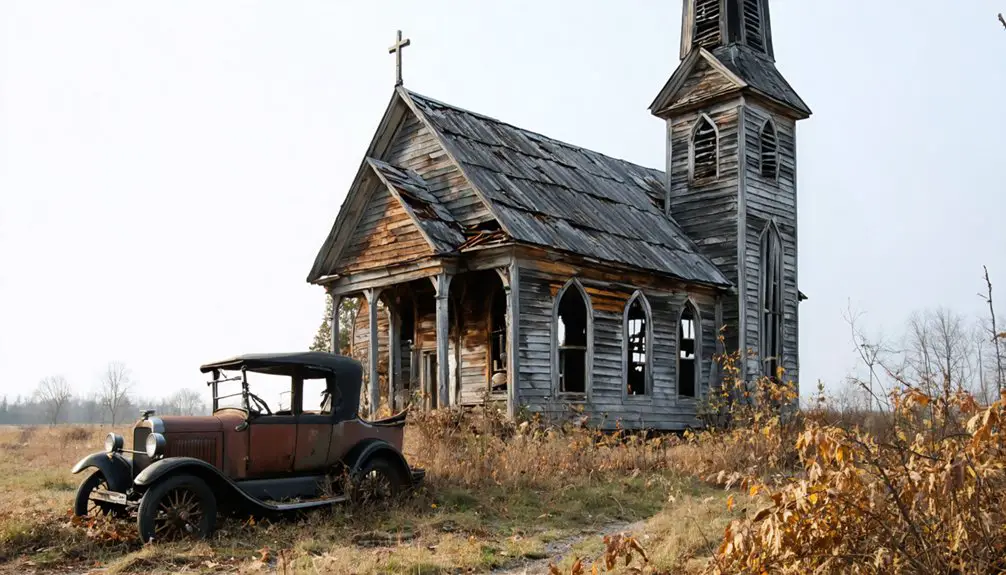
As Havre’s resource-based economy faltered in the early 20th century, a perfect storm of economic and transportation changes set the town on an irreversible path to abandonment. You’d have witnessed the gradual decline as mines closed and timber supplies dwindled, leaving workers with few alternatives.
Like countless boom towns before it, Havre’s fate was sealed when its mines went dry and timber ran scarce.
Environmental degradation from resource extraction made the area less livable, while new transport routes bypassed the town entirely.
- Your neighbors would’ve steadily departed as jobs disappeared, weakening community cohesion.
- You’d have seen local businesses, schools, and churches shut down one by one.
- Your town’s infrastructure would’ve deteriorated as the tax base shrank.
Without economic incentives to attract new residents or industries, Havre couldn’t recover. The Great Depression delivered the final blow, accelerating the exodus until the town faded into history.
What Remains Today
While sand dunes have reclaimed much of Havre’s original footprint, you’ll still find scattered remnants of this once-thriving town along Lake Michigan’s shoreline.
Occasional timber fragments and metal artifacts surface through shifting sands, while foundation outlines emerge during specific seasonal conditions. You can spot unusual spiral-growing trees marking underground features and cultural sites.
Archaeological discoveries have revealed household items, tools, and nails near exposed areas, with ground-penetrating radar detecting additional subsurface remains.
Today, you can access parts of Havre through public beach trails, where interpretive signs share the town’s story. Local museums display recovered artifacts, and nearby tourism centers offer guided tours.
Remember that any visible ruins are protected by regulations, ensuring these precious glimpses into the past remain for future generations to explore.
Legacy in Michigan History
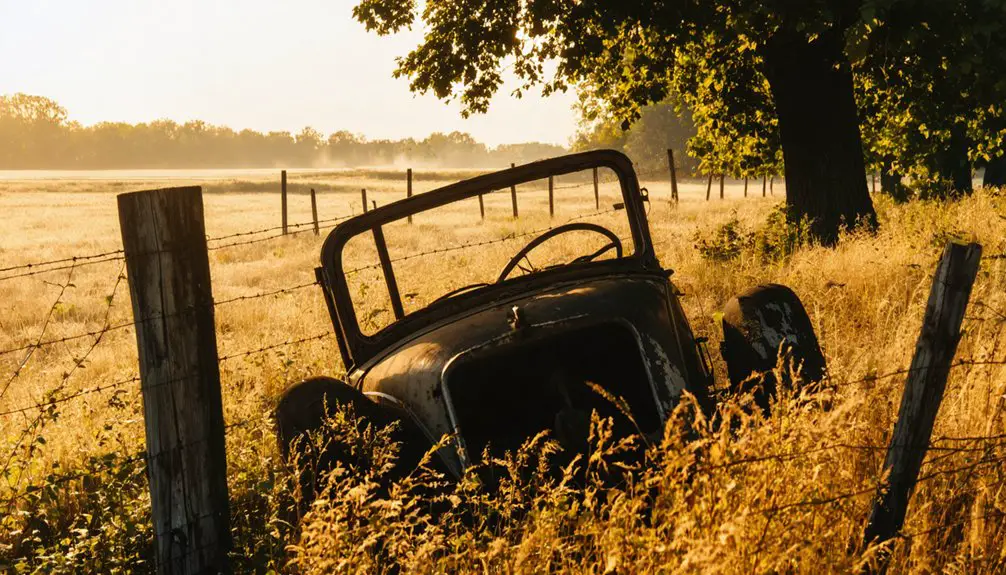
Through its unique disappearance beneath Lake Erie’s waters, Havre stands as a distinctive example of Michigan’s environmental and economic transformations.
You’ll find its story woven into the cultural memory of Michigan’s ghost towns, particularly documented since 1994 in regional historical literature. The town’s legacy illustrates the broader patterns of environmental transformation that have shaped the state’s communities.
- Havre demonstrates how natural resource economies influenced Michigan’s development and eventual shifts
- The town’s submersion serves as a powerful reminder of nature’s impact on human settlements
- Its preservation in historical records helps you understand the vulnerability of frontier communities
Today, Havre’s story continues to inform environmental historians and educate the public about Michigan’s changing landscapes, making it a significant case study in the state’s rich historical narrative.
Frequently Asked Questions
Are There Any Local Legends or Ghost Stories Associated With Havre?
You won’t find documented haunted locations or local folklore specifically tied to Havre’s history – published records and ghost town registries don’t mention any supernatural tales from this abandoned Michigan settlement.
What Happened to the Town’s Cemetery and Burial Records?
Time heals all wounds, but you won’t find much healing in this cemetery’s story. The burial records remain largely missing, while the cemetery itself suffers from neglect without organized restoration efforts.
Did Any Notable Michigan Historical Figures Ever Visit Havre?
You won’t find records of any famous visitors or historical figures stopping at Havre. The town’s limited historical significance and early abandonment mean prominent Michigan personalities likely never visited this location.
Were There Any Attempts to Revive or Resettle Havre?
You won’t find any documented revival efforts or formal resettlement plans for the town. Its remote location, deteriorated structures, and lack of modern infrastructure prevented serious attempts at bringing residents back.
Does Anyone Still Own Property or Land Titles in Havre?
You’ll find that property ownership in Havre remains unclear, with some land titles possibly held by descendants or transferred to state management through tax forfeiture, though specific records aren’t readily available.
References
- https://wrkr.com/lost-community-near-grand-haven-is-one-of-michigans-first-ghost-towns/
- https://99wfmk.com/one-of-michigans-first-ghost-towns/
- https://99wfmk.com/hamblen-holbrook/
- https://en.wikipedia.org/wiki/List_of_ghost_towns_in_Michigan
- https://kids.kiddle.co/List_of_ghost_towns_in_Michigan
- https://witl.com/one-of-michigans-first-ghost-towns/
- http://www.kristinascarcelli.com/michigans-ghost-towns-kensington-village/
- https://99wfmk.com/ghost-town-bell-presque-isle/
- https://www.nps.gov/slbe/learn/historyculture/ghosttowns.htm
- https://gandernewsroom.com/2023/06/28/7-michigan-ghost-towns-you-might-not-find-on-your-map-2/
